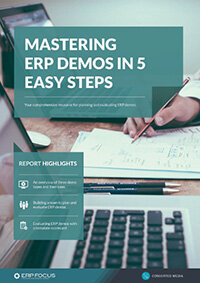Five key ERP features for e-commerce businesses
In a general sense, ‘e-commerce’ systems can be defined as a set of front-end applications oriented to buying, selling and executing transaction-based work products; whereas ERP platforms are more accepted as being back-end processing, and/or business intelligence toolsets. Consequently, from an enterprise perspective, these dissimilarities should be clearly understood whenever validating business decisions regarding either of these systems.
That said, however, for mid to large-scale firms, most enterprises employ both of these systems, with each serving important and useful business roles. In the far past these systems tended to operate as standalone variants, but over the years various integrations have emerged to create channelized data bridges between the two products.
Today, while various cloud systems have largely blurred functional differences by producing a sense of operational transparency between the two systems values, at a business level, ‘e-commerce ERP’ still requires necessarily discrete capabilities that only back-end ERP functionality can provide. Consequently, if you’re considering this type of integration, we thought we’d offer five important feature-sets to help you find a set of useful solutions.
1. Sophisticated interfaces
As one might expect, direct and transparent interfaces are paramount when melding two complex and highly-active applications, particularly when both sides of the front/back equation will undoubtedly involve large doses of mobility. Consequently, when considering an e-commerce ERP, ensure that all targeted modules offer system-to-system clarity, whether that means deep granularity on the data side, or clear commonalities at the user interface level.
2. Ability to establish consolidated dashboards
This particular element relates specifically to the last bit of advice. The more obvious a system to system user-interface is; the better chance a workforce will embrace a newly integrated platform. As mentioned earlier, today’s cloud ERP providers offer a number of ways to help this process along by providing various toolsets, including the delivery of standardized dashboards. In the event, most, if not all, elements associated with any system within the overall cloud framework can be applied internally, thereby allowing users to operate from a central common point-of-action.
3. Common data exchanges mechanisms
In this case, values similar to the aforementioned dashboards equally apply at the date-exchange level. In this case, not only do cloud providers offer hosts of ways to transparently move data elements from place-to-place, but the approach is further enhanced in the case of particular types of databases. For example, if you already utilize an SAP-based e-commerce engine, the provider already offers direct value on the ERP data side, since the brand applies common data characteristics from system to system.
4. End-to-end security compliance
ERP data security has become more critical during the last few years. Therefore, when looking a value points between an e-commerce system and an ERP, it is particularly important to ensure that all elements resident in both systems are directly compliant with each other, on top of applying as much intrinsic security as possible at the lowest levels of the system internal stack.
5. Easily delivered consolidated reporting
This might be stating the obvious, but, this boggle pops up regularly whenever enterprises attempt to integrate complex systems. In this case, the entire point of the effort really comes down to how well the entire complex delivers reporting on a consolidated basis. If one system encompasses a weak link, bad things can happen very quickly. This is the reason that, when validating an ERP with e-commerce functionality, you should start your investigation by quality-reviewing consolidated reporting first and work back. Because if the reporting side doesn’t work well, chances are that the rest of the complex won’t work very well either.
Free white paper

70 features to look for in your next ERP
A comprehensive guide to help you identify requirements for your ERP selection

Featured white papers
-

ERP Software Pricing Guide
Get the latest pricing information on over 80 popular ERP systems, and learn how to budget for your ERP project in our free guide
Download -

60-Step ERP Selection Checklist
Get the comprehensive checklist for your ERP selection project
Download -

ERP Demo Guide & Scorecard
Master your ERP demo with 5 easy steps using our free guide (includes demo scorecard)
Download
Related articles
-

Nine signs you need an eCommerce ERP integration
A guest blog from Brightpearl discussing eCommerce ERP and integration
-

Secret KPI: Why Your ERP Implementation Team Matters More Than Software
Learn how Godlan ensures successful ERP implementation for manufacturers with proven strategies &...
-

The best ERP systems for process manufacturing
Consider these ERP systems when selecting your next process manufacturing ERP

